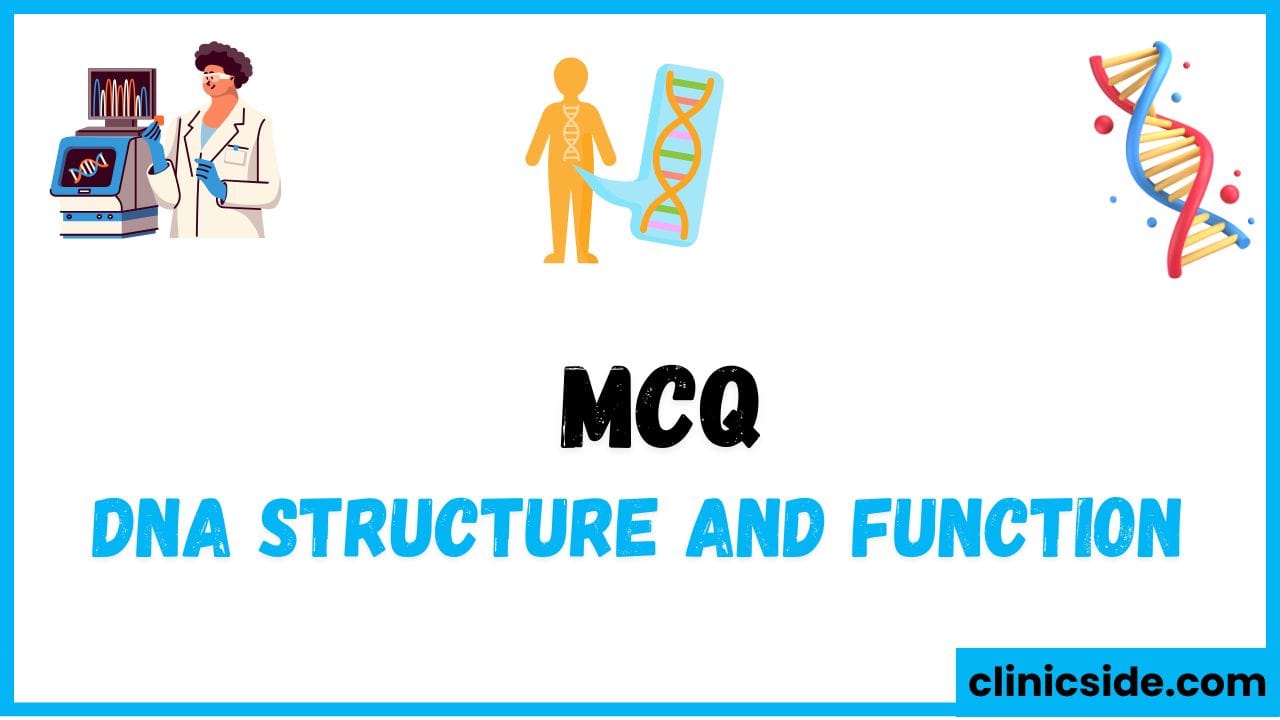Multiple Choice Questions
Topics Covered in DNA Structure and Function MCQs
This set of multiple-choice questions focuses on essential topics related to DNA’s structure and function. These questions help students understand key principles of genetics, DNA replication, and molecular biology.
1. Full Form of DNA
- The full form of DNA is Deoxyribonucleic Acid. This molecule is fundamental to life as it carries genetic information critical for growth, development, and reproduction in all living organisms.
2. Location of DNA in the Cell
- DNA is primarily located in the nucleus of eukaryotic cells. In prokaryotic cells, which lack a defined nucleus, DNA is found in the cell’s cytoplasm.
3. Double Helix Structure of DNA
- DNA’s structure is described as a double helix, a discovery made by James Watson and Francis Crick. The double-helix model resembles a twisted ladder, with the sugar-phosphate backbone forming the sides and paired nitrogenous bases as the rungs.
4. Discovery of DNA Structure
- James Watson and Francis Crick are credited with discovering DNA’s double-helix structure in 1953, a landmark achievement that laid the foundation for modern genetics.
5. Base Pairing and Hydrogen Bonds
- The two strands of DNA are held together by hydrogen bonds between paired nitrogenous bases. Adenine (A) pairs with thymine (T), and guanine (G) pairs with cytosine (C).
6. DNA Replication Process
- DNA replication is semi-conservative, meaning that each new DNA molecule consists of one original strand and one newly synthesized strand. This process ensures accurate transmission of genetic information during cell division.
7. DNA Backbone Composition
- The backbone of DNA is composed of sugar (deoxyribose) and phosphate groups, providing structural stability to the molecule.
8. Complementary Base Pairing
- In DNA, specific base pairing occurs: adenine pairs with thymine, and guanine pairs with cytosine. This base pairing is essential for DNA replication and transcription accuracy.
9. Enzymes Involved in DNA Replication
- Enzymes such as helicase and DNA polymerase play crucial roles in DNA replication. Helicase unwinds the DNA, while DNA polymerase adds nucleotides to form the new strand.
10. Nitrogenous Bases in DNA
- DNA contains four nitrogenous bases: adenine (A), thymine (T), cytosine (C), and guanine (G). Unlike RNA, DNA does not contain uracil (U), which replaces thymine in RNA.
11. Sugar in DNA
- The sugar found in DNA is deoxyribose, a five-carbon sugar that differs from ribose (found in RNA) by lacking one oxygen atom, hence the name “deoxy.”
12. Transcription Process
- Transcription is the process by which DNA is used as a template to synthesize RNA. This RNA then guides protein synthesis in cells, carrying out DNA’s instructions.
13. Complementary DNA Sequence
- DNA’s complementary nature ensures that one strand can serve as a template to form another. For instance, if one strand has the sequence ACGTAC, the complementary strand would be TGCATG.
14. Genetic Information in DNA
- DNA’s genetic code is stored in the sequence of nitrogenous bases. These bases determine the sequence of amino acids in proteins, dictating traits and cellular functions.
15. DNA Replication in the Cell Cycle
- DNA replication occurs during the S phase of the cell cycle. This replication ensures that each daughter cell receives a complete set of genetic material.
16. Types of Bonds in DNA
- Covalent bonds link nucleotides along the DNA’s backbone, while hydrogen bonds connect the nitrogenous bases across the two strands. Covalent bonds provide structural integrity, while hydrogen bonds allow the strands to separate during replication.
17. Base Pairing Rules
- The rules of base pairing are fundamental to DNA’s structure and function: adenine pairs with thymine (A-T), and guanine pairs with cytosine (G-C). This pairing is essential for accurate DNA replication and transcription.
18. Importance of DNA Structure in Biology
- DNA’s structure and replication mechanisms are central to understanding genetics, heredity, and cell biology. The double helix model also explains how DNA can replicate accurately and how mutations may lead to changes in genetic information.





